Some time in the middle of 2007 we noticed that a pair of peregrine falcons, relatively rare around the Central West of New South Wales, were interested in using Charles Sturt University’s Orange campus as a hunting ground.
Ian Grange, a member of staff, suggested we mount a roosting box high up in the water tower, on the south window to encourage the raptors to hang around. They took to the box very quickly and no end of carnage was brought in to consume.
IP cameras were located and mounted – one inside the box above the floor and the other one up high overlooking the ledge and their flight approach.
Since then we’ve been receiving brilliant close-up footage and experiences from our new acquaintances with every intention of making our coverage and data available to the world. We’ve come to know the adult pair well now and consider them a part of campus. Not often anyone can get this close to such amazing raptors!
You can follow the full timeline below and check out our blog for more information about each event.
Initial ideas and plans to build and mount a roost for a pair of curious peregrines; roost installed, cameras “borrowed” and connected, providing first images.
Falcon adults appear frequently to use the roost as a feeding post.
a violent thunderstorm in the afternoon resulted in a direct strike on the water tower, a mere 10 feet away from the nest; potentially fatal for both peregrines and their eggs.
First visits from TV news crews, reporting on our feathered family.
We received a visit from representatives from members of disbanded RAAF 30 Beaufighter Squadron whose emblem fittingly was a peregrine with a lightning bolt.
(Day 40) Right on target, Migii is fully fledged and beginning to find the nest unbearably small.
Migii flies off this morning on the maiden flight (just over 6 weeks old); the roost returns to normal.
Adult pair spotted mating on the top of the water tower.
The second season begins with three eggs laid.
Two of the three eggs hatch.
The third egg hatches, giving us a 300% increase on last year’s first recording season.
Our third active breeding commences.
Third egg appears for the third project breeding season; incubation begins.
Successful public previews of 'The FalconCam Project' 23-minute movie presentation.
Solo flies off, completing our third season’s fledging.
Swift and Beau are preparing their scrape for our 4th observed breeding season.
Fourth observed breeding season commences with first egg laid.
Live video streaming capability to the Internet established; ongoing upgrades and improvements.
Hatching of all three eggs; Narrambla, Ophir and Byng join us.
Live video streaming moved to Charles Sturt-based web pages due to 20x normal website traffic hits; new HD nest camera arrives (in testing).
Three eggs laid for Season 6; One egg was destroyed by the peregrines.
Both cameras are now running in high-definition for surveillance and observation. These are AXIS P3344 cams.
There was only one chick this year, Aspro and he was unfortunately, blown out of the box a week before he was due to fledge and was never found.
Bula disappeared at first hatching time and was replaced after a couple of weeks by Xavier (from Saviour as he saved the season).
He didn’t help with brooding or feeding the chicks, but he provided for the family and we had three successful fledglings: Vim (m), Mell (f) and Rubi (f).
Seems like a pattern: three eggs, two hatched. Both successfully fledged: Gaia (f) and Pluto (m), but Gaia not seen again after three days after fledging. Xavier developing into a really good father, but every year he has to be trained again to ‘give up’ his prey!
 Nearly lost the season (potentially) because of major works to be undertaken due to a leak in the water tower. A last minute stay of execution means the works have been postponed until after the season. It was noticed that prey were coming in up to 7 times a day during courtship and almost stopped once eggs were laid.
Nearly lost the season (potentially) because of major works to be undertaken due to a leak in the water tower. A last minute stay of execution means the works have been postponed until after the season. It was noticed that prey were coming in up to 7 times a day during courtship and almost stopped once eggs were laid.
New ‘box cam’ is installed. This is a top quality HikVision cam and gives a good, clear image of the whole box and ledge and, once a microphone was added, good sound.
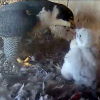 Only one chick fledged a male called ‘Izzi’ (Arab for ‘mighty’). A second chick hatched, but only survived a few days. Izzi proved to be something of a character. He fledged several times (and was returned to the box twice, once after a premature fledge and the second time after hitting a window and a week in rehab). He didn’t leave the area until August 2021 when the parents started to block his entry to the nest box.
Only one chick fledged a male called ‘Izzi’ (Arab for ‘mighty’). A second chick hatched, but only survived a few days. Izzi proved to be something of a character. He fledged several times (and was returned to the box twice, once after a premature fledge and the second time after hitting a window and a week in rehab). He didn’t leave the area until August 2021 when the parents started to block his entry to the nest box.
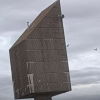 A ‘new’ Axis P1448 cam, “tower cam” commenced streaming. This was donated by the Paul Carter of Captivaction. It had been recording the demolition of old building and construction of the medical faculty buildings and was donated to the project when no longer needed.
A ‘new’ Axis P1448 cam, “tower cam” commenced streaming. This was donated by the Paul Carter of Captivaction. It had been recording the demolition of old building and construction of the medical faculty buildings and was donated to the project when no longer needed.
This gives a quite different view of the tower from the outside, so we can record their use of the tower and provide some spectacular flying images.
Available free at the Corella website
Fledgling of Barru (male) and Marri (female). Both fledged well, but only one (Marri) survived until dispersal in early February.
The new ‘tower cam’ was installed in December 2023. There were quite a few teething problems and it wasn’t really stabilised until now. The new cam gives us vision at night and we have started observing the adults hunting at night. The prey are hard to identify at this distance, but a few have also brought into the box: masked lapwings, quail, grebes etc.
2nd paper published: Kinross, C. (2025) ‘Year-round courtship and maintenance of pair-bonds at a Peregrine Falcon Falco peregrinus nest-box’. Corella. vol. 49. Will be available on the Corella website from March 2026. Up until that time you can obtain a copy by emailing the author: ckinross@csu.edu.au
After mating that very morning and eggs due, Xavier disappeared, presumably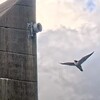 killed in a hunting accident. Despite extensive searches, we didn’t find his body. Xavier had been Diamond’s mate since 2016 and will be sorely missed with his quirky ways and amazing dance routines when bonding
killed in a hunting accident. Despite extensive searches, we didn’t find his body. Xavier had been Diamond’s mate since 2016 and will be sorely missed with his quirky ways and amazing dance routines when bonding
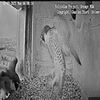 A young male still in sub-adult plumage turned up today. Being so young (just under a year) he’s unlikely that he had anything to do with Xavier’s disappearance. More likely, he is ‘floater’ looking for a new mate and home. We get several of these during the year and all have (so far) been chased away.
A young male still in sub-adult plumage turned up today. Being so young (just under a year) he’s unlikely that he had anything to do with Xavier’s disappearance. More likely, he is ‘floater’ looking for a new mate and home. We get several of these during the year and all have (so far) been chased away.
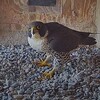 After a week, the young Gimbir (Wiradjuri for ‘spring’ or ‘fountain’) has met many milestones: he started by pair-bonding, then brought prey (pigeon), and has since scraped and mated twice after some early missed attempts. Diamond seems quite taken with him. Eggs this year are unlikely, but far from impossible.
After a week, the young Gimbir (Wiradjuri for ‘spring’ or ‘fountain’) has met many milestones: he started by pair-bonding, then brought prey (pigeon), and has since scraped and mated twice after some early missed attempts. Diamond seems quite taken with him. Eggs this year are unlikely, but far from impossible.